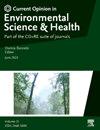长期接触饮用水中的邻苯二甲酸盐:对公众健康的影响
IF 6.6
Q1 ENVIRONMENTAL SCIENCES
Current Opinion in Environmental Science and Health
Pub Date : 2025-02-14
DOI:10.1016/j.coesh.2025.100602
引用次数: 0
摘要
邻苯二甲酸酯是最普遍的增塑剂,以其内分泌干扰特性而闻名,因此引起了重大关注。作为日常摄入的重要组成部分,饮用水中的邻苯二甲酸盐污染对人类健康构成威胁,但邻苯二甲酸盐通过饮用水终身暴露的概念仍未得到充分探讨。本综述总结了整个饮用水系统的邻苯二甲酸盐水平,包括原水源、饮用水处理厂、自来水和瓶装水,重点介绍了市政自来水中邻苯二甲酸盐浓度达到1438 μg/L的情况,在某些地区远远超过了世界卫生组织8 μg/L的指导标准。来自塑料水管和各种水过滤元件的二次污染导致邻苯二甲酸盐的多样性,饮用水中存在多达22种邻苯二甲酸盐。我们强调,长期接触饮用水中的邻苯二甲酸盐会导致生物积累,从而对不同年龄组的健康产生影响,例如,生殖失调、神经紊乱以及肥胖和高血压等其他慢性疾病。利用生态结构活性关系(ECOSAR)框架对邻苯二甲酸酯的急性和慢性毒性进行了评价,发现邻苯二甲酸酯的毒性随结构复杂性的增加而加剧,慢性毒性明显比急性毒性复杂。邻苯二甲酸盐造成的潜在健康风险,特别是其累积的慢性毒性和通过受污染的饮用水终身接触,需要采取积极和先发制人的措施。本文章由计算机程序翻译,如有差异,请以英文原文为准。

Chronic exposure to phthalates in drinking water: The implications on public health
Phthalates are the most prevalent plasticizers and are known for their endocrine-disrupting properties, hence posing significant concerns. As a vital component of daily intake, phthalate contamination in drinking water poses risks to human health, yet the concept of phthalate as lifelong exposome through drinking water remains underexplored. This review summarizes phthalates levels throughout the drinking water system, including raw water sources, drinking water treatment plants, tap water, and bottled water, highlighting instances where concentrations reaching 1438 μg/L in municipal tap water, far exceeding the World Health Organization guideline of 8 μg/L in some areas. Secondary contamination from plastic water pipes and various water filter elements contributes to the diversity of phthalates, with up to 22 phthalate types present in drinking water. We emphasized that the chronic exposure to phthalates in drinking water leads to bioaccumulation, resulting in health implications across different age groups, for instance, reproductive dysregulation, neurological disorders, and other chronic diseases such as obesity and hypertension. Utilizing the Ecological Structure Activity Relationships (ECOSAR) framework, we evaluate the acute and chronic toxicity of phthalates, revealing that phthalates toxicity aggravates with structural complexity, and chronic toxicity significantly more complicated than acute toxicity. The potential health risks caused by phthalates, particularly their cumulative chronic toxicity and lifelong exposome through contaminated drinking water, necessitate proactive and pre-emptive measures.
求助全文
通过发布文献求助,成功后即可免费获取论文全文。
去求助
来源期刊

Current Opinion in Environmental Science and Health
Medicine-Public Health, Environmental and Occupational Health
CiteScore
14.90
自引率
0.00%
发文量
92
审稿时长
114 days
 求助内容:
求助内容: 应助结果提醒方式:
应助结果提醒方式:


